|
VISITORS BOOKS
- a theatrical boarding house in Wolverhampton
by Val Wood
Hamilton, New Zealand
My maternal grandparents Edward and Louisa Handley kept a boarding
house in Wolverhampton from 1898 till 1918.
 |
Louisa Handley, proprietor of a theatrical boarding
house, first in Queen Street, than in Bond Street, Wolverhampton.
Grandfather Handley had been a
soldier for over 20 years in the South Staffordshire Regiment and
twelve of those years were spent in India during the time of the
Mutiny.
|
|
This old and age-spotted photo shows Edward Thomas
Handley, in the centre with the medals. I do not know who the other four
men are - but they may be his brothers.
He retired on a fairly small pension and to help feed his family he took
a job as stage-door keeper at the Grand Theatre. As an extension of this
work his wife had theatrical people to board while the various shows
were playing in Wolverhampton.
|
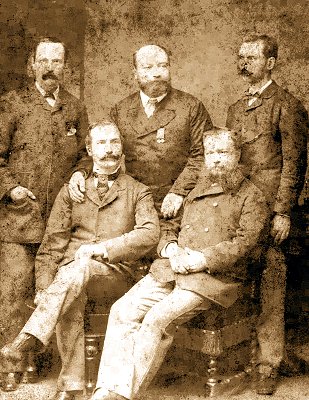 |
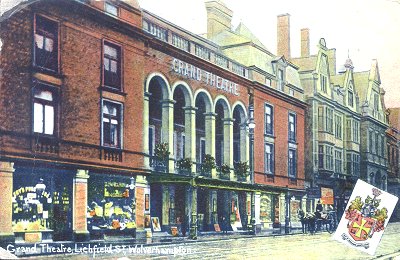
This old postcard is postmarked 1909 so it almost
certainly shows the Grand as Edward and Louisa Handley would have known
it. |
They lived at 25A Queen Street, upstairs above a shop; the
accommodation must have been a reasonable size as the couple had two
daughters and a live in maid as well. |
| I have some of the visitors books that guests signed as they left
after staying with my grandparents and reading the entries is a trip
down memory lane. What sort of people were they who travelled all over
the country acting in the different shows? Did they get lonely and
homesick? Were the landladies a sort of mother substitute? It is no
wonder that some of them stayed in the same boarding house time after
time. It would become like a second home, seeing the same faces and
perhaps sleeping in the same room and bed. Lily Lilford, who played in the Telephone Girl in 1899, wrote in a
large and flourishing handwriting how much she had enjoyed her stay - as
well as passing on the address to others she would be coming back
herself. Over the page are Jessie and Eva from the ‘Beauty and the Beast
Company’. They stayed for two whole weeks for the Christmas pantomime. I
wonder if they were the main parts or just two lassies in the chorus?
Members of the ‘Turner Opera Company’ were followed closely by the
‘Christian Company’, all enjoying the food and comfortable beds. A
Chinese Honeymoon was next and then two of the cast of The Belle of New
York stayed a little while. In the middle of 1900 some members of a
group showing an early cinematograph, called Hearts are Trumps, stayed.
This was surely one of the first of the soap operas? |
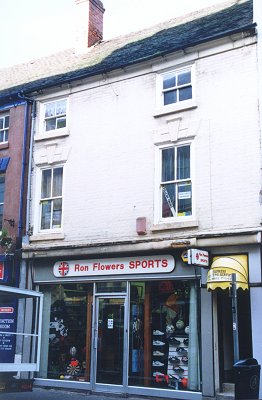
25 Queen Street in 2001. The street does
not seem to have been re-numbered and the building of this house
easily pre-dates the time Louisa used it as a boarding house. |
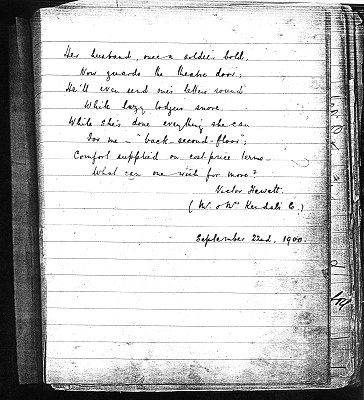
A page from one of the visitors' book. The
books were exercise books and are now very battered. |
A poet leaps out of the next page with an ‘Ode to dear Mrs Handley
and her soldier husband who now guards the theatre door.’
Then came the
"Merry Madcaps’ and ‘the White Heather Company’. John J Hooker wrote
"Everything comfortable, everything Al". He played in the ‘Auld Lang
Syne Company’, as did Wilfred and Percy, one of whom wrote "Paradise
Personified" and the other "Quite the nicest digs I have ever had, I
could die here! In fact I have."
Someone from a rival company added "I
bet Mrs Handley has died of long suffering putting up with you lot."
Three sisters, Mary, Eva and Violet, write "Don’t forget the swings." J.
Williams, with a bold flourish, tells everyone he is not only the
conductor of the show but he is the composer as well. |
| One page is headed up like a letter, with the address of the Empire
Theatre. Grandmother is thanked in the usual flourishing words and then
tucked away to the side of the page is a recipe for a marvellous cure
for bronchitis.
I cannot read all the ingredients, only camphor, but, as
my Mother suffered from bronchitis all her life, I do not think the cure
was all it was supposed to be.
For three weeks in 1902 members of the
British Imperial Band stayed at the house. When it came time to leave
they listed all the other bands they had played for: Life Guards, Scots
Guards, Royal Marines and even the Carl Rosa Opera Company. I hope they
did all their practising at the theatre. |
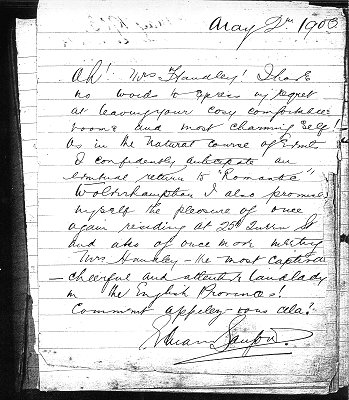
Another page from the books. On this page a
thespian expounds at great length. |
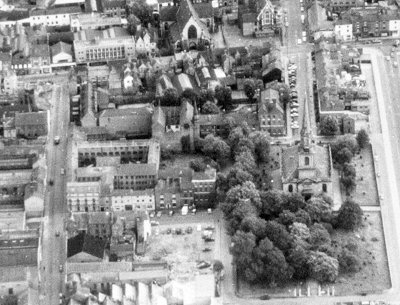
An aerial photo taken not long after Ring Road St. John's was built. Bond
Street runs across the photo from the east end of St. John's to Temple
Street. No. 6 is the house immediately right of the white-fronted
building. |
Over the pages and several months later comes another visit from
Barney Stuart of the bronchitis cure. This time he uses large printing
and sweeping arrows to draw everyone’s attention to A GOOD AND IMMEDIATE
CURE FOR RHEUMATISM. He must have been a frustrated doctor, as once
again the recipe is almost unreadable. As the books fill up there is the occasional reference to my Mother
helping out. Her father died in 1906 so the boarders became the sole
source of income for the family as Edward Handley’s army pension ceased
when he died. The family moved to 6 Bond Street and still the boarders
came.
|
| As they grew up it must have been a marvellous life for
my Mother, Vera, and her sister Grace, always new and exciting people
coming to stay. An added bonus was seeing all the shows at the different
theatres, mostly from the wings.
Mother said she was quite grown up
before she ever saw a performance from the front of the house. |

On the right is St. John's vicarage. The
archway in the centre of the third building down the street divided
No.6, on the left, from No.7 on the right. Bond Street
would have been further from the theatres than Queen Street, but much
quieter and more "respectable", and the house might well have been
bigger, as the Ordnance Survey map shows this house stretching a long
way back. Courtesy of David Clare. |
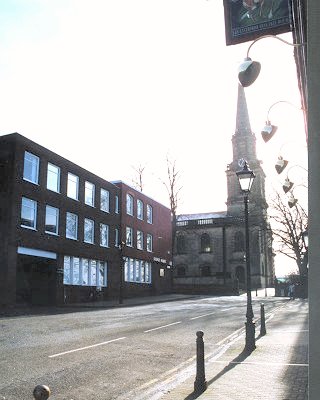
Bond Street today. No. 6 is somewhere
under the office block. |
One thing that stands out in these visitors books is the
handwriting - such big bold scripts. It was nothing for a writer to fill
up half a page with only a few words. Some have beautiful, even writing;
others are almost unreadable. Many different-coloured inks were in use -
a lovely lavender ink was used by members of an Italian Opera company
but were their thank you notes, written in Italian, ever understood?
The last entries in the books are from a different kind
of boarder: New Zealand soldiers who had lost legs or arms on the battle
fields of France. After long spells in hospital they were sent up to the
Midlands to learn new trades before returning home to New Zealand. These
men enlivened the life of my Grandmother and her daughters, always
playing jokes and good for a laugh.
One favourite joke was to re-tie the
apron strings of Grandma’s white apron to the back of her chair so she
had difficulty getting up. Even as an older man my Dad would have a
chuckle about the look on her face when she couldn’t get up.
|
As well as helping with the boarders Vera and Grace
worked. In the memoranda pages of her communion book Vera neatly
recorded the major events of her life:
Born Sept. 13 1896.
Commenced School Sept. 1901.
Left School Sept. 1910.
Started work at Chowen's Cafe July 1912.
Left Feb 1913.
Started work at Langman's Pawnbroker July 1913.
Left December 1913.
Commenced at Tilley's Fruiterers May 1914.
Left August 1916
Commenced work on munitions at James Gibbon's August 3rd 1916. |
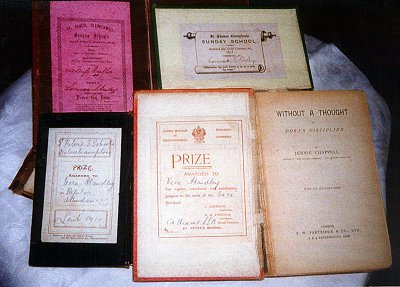
Book plates in prizes awarded to Vera Handley at
St.Peter's School and St.Peter's Sunday School, Wolverhampton. |
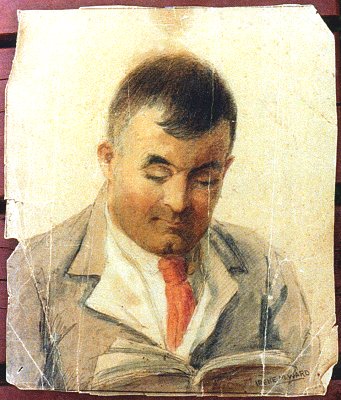
Private Charles Heaphy, from a water colour by
Irene M. Ward, painted while Charles was in hospital during World War 1. |
Vera worked 12 hours a day in James Gibbon’s munitions
factory, making hand grenades. Although the hours were long there must
have been some time for romance because in October 1918, one week before
the end of the war my Mother, Vera Handley, married Charles Heaphy of
New Zealand and sailed with him on a troopship to New Zealand.
Charles Heaphy was a New Zealander who had come to
Europe as a soldier during the First World War. He was wounded and
was sent to hospital in England.
When he recovered he was sent to Wolverhampton
as part of a scheme for retraining Commonwealth soldiers before
they returned home. Charles and many other NZ soldiers
were trained at Guy Motors.
|
| In Wolverhampton he met my mother, Vera - and soon knew her
well enough to sign her autograph book, as seen below. |

Charles Heaphy (far left) with other soldiers during
training at Guy Motors. |
 |
Vera Handley's autograph book open at the page where
the poem "The Night has a Thousand Eyes" has been written out and signed
"8/3625 Pte. C. Heaphy, 2nd Company, 2nd Otago Battalion, NZE7".
In
front is her communion book, given her by Robert Allen of St.John's on
10th March 1915, when she was confirmed at St.Chad's church. |
| Another entry in the autograph book is by her cousin,
Guardsman Lawrence Arundel, of Wolverhampton and the Coldstream Guards,
dated December 1918. |
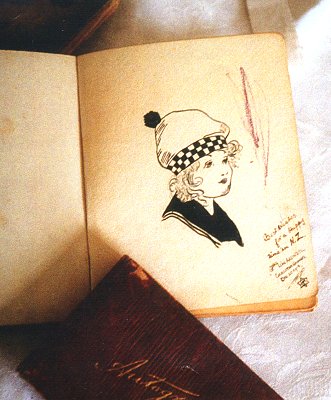 |
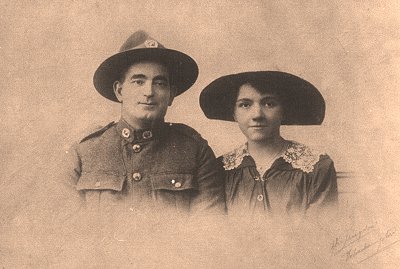 |
Romance blossomed between Vera and Charles.
Wedding photo of Charles and Vera Heaphy, 16th
October 1918, St. John's, Wolverhampton.
|
| Guy Motors (still "under government control") gave
Charles Heaphy this reference on 9 December 1918.
They say he has
had experience in machine tools and in working with combustion engines;
that he has "taken a keen interest in any work he has been given to do"
and that they "feel sure he will prove quite a useful man". |
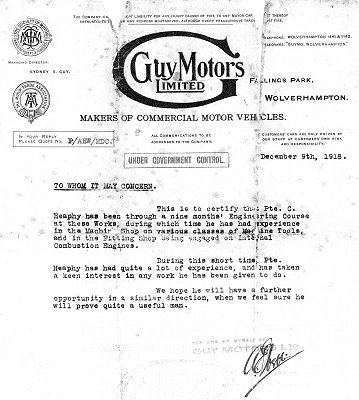 |
On 10th October 1918 Vera stopped working for James
Gibbons and on the 16th she married Charles at St. Johns church.
Charles and Vera sailed for New Zealand, the boarding house gradually
closed as my Grandmother and her daughter Grace prepared to come to New
Zealand when a berth on a ship was available. Sadly Louisa Handley took
sick and died in May 1920 and Grace came out by herself to join her
sister.
Note: Val Wood's book "War Brides: They Followed
their Hearts to New Zealand", Random Century New Zealand, 1991, is an
account of the war brides who went to New Zealand after the First and
Second World Wars.
 |
 |
 |
Return to the
Easthope Family |
Return to the
Handley
Family |
Return to Lives
of Local
People |
|













